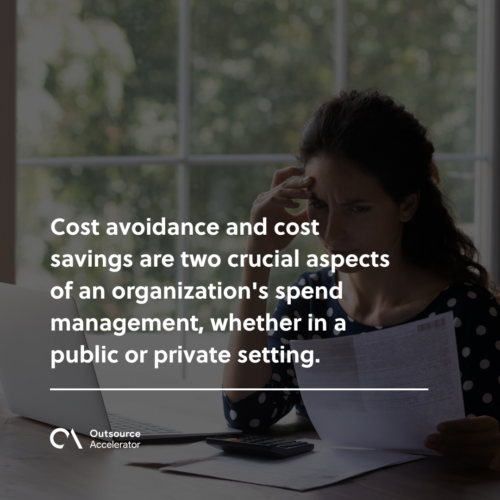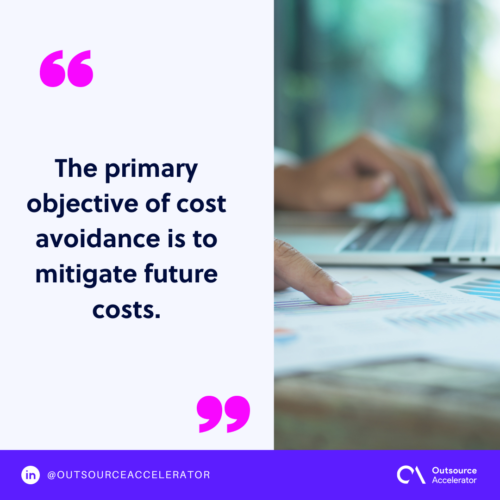Cost avoidance vs. Cost savings: Understanding the difference

The concepts of cost avoidance and cost savings have gained significant prominence as organizations strive to optimize their financial performance. The two terms are also used as procurement metrics for most teams.
While these terms may appear interchangeable at first glance, a closer examination reveals differences that can greatly impact procurement processes and an organization’s bottom line.
Understanding the disparity between cost avoidance and cost savings is crucial for businesses aiming to make informed financial decisions and maintain better procurement workflows.
This article delves into the comparison between cost avoidance and cost savings.
Cost avoidance vs. Cost savings
Cost avoidance and cost savings are two crucial aspects of an organization’s spend management, whether in a public or private setting.
While both relate to reducing expenses, cost avoidance and cost savings approach the task from different angles. Cost avoidance emphasizes preventing unnecessary expenses, while cost savings focus on reducing current expenses.
Procurement teams must be able to define and compare the two aspects and how to calculate each.

Defining cost avoidance
Cost avoidance refers to the proactive actions taken to prevent expenses that may arise in the future. It involves identifying potential costs and taking proactive measures to eliminate or minimize them.
This aspect is known as “soft savings” since cost avoidance calculation mostly relies on projections and theories. With this, cost avoidance is not usually reflected in an organization’s financial statements.
Cost avoidance aims to avoid unnecessary expenditures and can be a long-term strategy for maintaining financial stability. It sometimes means investing in an expensive solution to save money in the long run.
Calculating cost avoidance
There are two ways to calculate cost avoidance: as an amount and as a percentage.
To calculate it as an amount, estimate the projected cost of inaction, then subtract it from the cost of proactive solution.
Its formula goes as follows:
Cost avoidance amount = Estimated cost of inaction – the cost of proactive solution
Meanwhile, to calculate as a percentage, get the avoided amount as mentioned above and divide it into the cost of inaction.
This goes as follows:
Cost avoidance percentage = Cost avoidance amount / cost of inaction
Calculating cost avoidance requires careful evaluation of the potential expenses that could be incurred. It involves assessing different scenarios and estimating the financial impact of each.
Examples of cost avoidance
Cost avoidance is applied in different ways as long as it can help lower costs in a function.
Some examples include the following:
- Technology upgrades. Regular system updates and maintenance can prevent costly breakdowns and disruptions, saving on repair and replacement expenses.
- Training and development. Providing employees with adequate training and development opportunities can prevent errors and improve productivity, avoiding the costs associated with mistakes or inefficiencies.
- Proactive maintenance. Regular inspections and maintenance of machinery and equipment can prevent unexpected breakdowns, reducing downtime and avoiding the expenses of emergency repairs.
Characteristics of cost avoidance
Cost avoidance is characterized by the following:
Long-term vision
Cost avoidance operates with a long-term perspective in mind. It goes beyond immediate cost reduction and focuses more on strategic budgeting and planning.
Proactive approach
Cost avoidance adopts a proactive approach to cost management. Instead of reacting to expenses as they arise, it identifies potential costs and takes preventive action.
Future cost mitigation
The primary objective of cost avoidance is to mitigate future costs. It achieves this by implementing preventive measures that eliminate or minimize potential expenses.

Strategic analysis and evaluation
Cost avoidance requires careful analysis and evaluation of potential expenses in a resource. It takes into account market trends, industry regulations, and internal operations that could affect its price.
Holistic approach
Cost avoidance takes a holistic approach to cost management. It considers various aspects of the business, including workflows, technology, and employee training.
Risk mitigation
Cost avoidance aims to mitigate business risks by proactively addressing potential expenses. This proactive risk management contributes to avoiding costly disruptions, unexpected breakdowns, and legal or regulatory penalties.
Sustainable savings
Cost avoidance creates sustainable savings over time. Businesses can maintain consistent financial performance and avoid sudden budget shocks by preventing unnecessary expenses.
Continuous improvement
Cost avoidance encourages a culture of continuous improvement within an organization. This constant improvement mindset extends beyond cost management and positively impacts overall operational efficiency.
Defining cost savings
Unlike cost avoidance, which focuses on preventing future expenses, cost savings involves reducing existing costs to enhance the financial position of a business. It aims to optimize spending and streamline operations for more efficient resource utilization.
Also known as “hard savings,” cost savings are usually reflected in a company’s financial statement and budget.
Calculating cost savings
Calculating cost savings involves analyzing current expenses and identifying areas where reductions can be made.
To calculate cost savings as an amount, take the initial pre-negotiated cost of a contract and subtract it from the final contracted price.
This is shown as follows:
Cost savings = Initial cost – contracted price
The initial cost can be seen through the initial budgeted amount or the supplier’s initial offer in procurement. Though at some point, some teams prefer to calculate cost savings as a percentage.
To get cost savings as a percentage, subtract the final contracted cost from its initial price and divide the initial cost by its difference.
This formula shows the result:
Difference = Initial price – final contracted cost
Cost savings percentage = Difference / initial price
By evaluating different cost elements, such as overhead, production, or procurement, organizations can uncover opportunities for saving money without compromising quality or efficiency.
Examples of cost savings
Cost savings can reflect in different forms, including the following:
- Price negotiations. To avoid future cost increases, owners can negotiate with their suppliers for long-term contracts with price protection or additional offer.
- Energy conservation. Implementing energy-efficient practices and technologies can reduce utility bills, resulting in substantial savings over time.
- Supply chain optimization. Streamlining the supply chain, negotiating better deals with suppliers, and optimizing inventory management can save costs through reduced procurement expenses.
- Process automation. Automating repetitive tasks and optimizing workflows can improve productivity and reduce labor costs, resulting in significant savings.
Characteristics of cost savings
Cost savings are characterized by the following:
Short-term focus
Cost savings primarily focus on achieving immediate financial gains. It emphasizes identifying and reducing existing costs to enhance profitability and efficiency.

Analytical approach
Cost savings require a meticulous and analytical approach. It involves evaluating current expenses, analyzing cost drivers, and identifying areas where reductions can be made without compromising quality or productivity.
This analytical mindset enables organizations to plan better cost-cutting measures.
Operational efficiency
One of the main objectives of cost savings is to improve operational efficiency. Businesses can reduce costs by streamlining processes, eliminating waste, and optimizing resource allocation while maintaining or enhancing productivity.
As a cost-saving measure, outsourcing maintains this characteristic of cost savings. This focus on efficiency ensures that cost savings efforts align with overall business objectives.
Resource optimization
Cost savings strategies emphasize optimizing the use of resources. This involves identifying areas of overspending, renegotiating contracts with suppliers, or finding more cost-effective alternatives without sacrificing quality.
Continuous monitoring
Cost savings is an ongoing process that requires continuous monitoring and improvement. It involves regularly reassessing expenses, identifying new cost-saving opportunities, and adapting to changing market conditions.
This continuous improvement mindset ensures that cost savings efforts remain effective and sustainable over time.
Collaborative effort
Achieving substantial cost savings requires collaboration across different departments and teams within an organization. It involves fostering a culture of cost consciousness and encouraging employees to contribute their ideas for cost reduction.
By involving everyone in the organization, businesses can tap into collective expertise that leads to innovative and impactful cost-saving initiatives.
Financial discipline
Cost savings necessitates financial discipline throughout the organization. It involves adhering to budgets, closely monitoring expenses, and implementing cost controls.
Benchmarking and best practices
Cost savings initiatives often involve benchmarking against industry standards and identifying best practices.
By comparing performance metrics and learning from successful companies, organizations can uncover new cost-saving strategies. They can adopt proven methods that have yielded positive results elsewhere.
Cost avoidance vs. Cost savings: When to use each aspect
Determining when to use cost avoidance or cost savings depends on a business’s specific circumstances and objectives.
Here are some guidelines to help decide which aspect to prioritize:
- Cost avoidance. Use cost avoidance when potential future expenses can be mitigated through preventive measures. It is beneficial for long-term financial stability and strategic planning.
- Cost savings. Prioritize cost savings when there is a need to optimize current expenses and improve operational efficiency. It is suitable for short-term financial gains and immediate cost reductions.
Cost avoidance and cost savings are two essential concepts in financial management. While cost avoidance focuses on preventing future expenses, cost savings emphasize reducing costs.
Both aspects are crucial in optimizing a business’s financial health and stability. Organizations create a robust financial strategy balancing long-term vision and short-term gains through a proactive approach with cost avoidance and a reactive approach with cost savings.







 Independent
Independent




